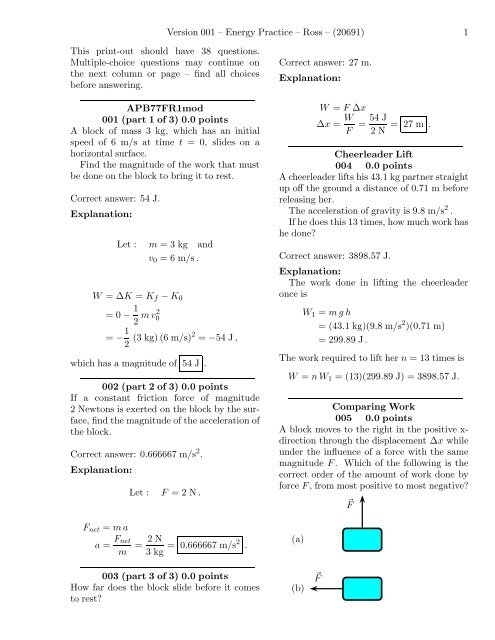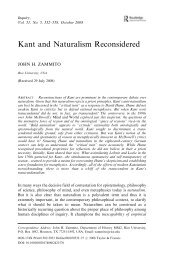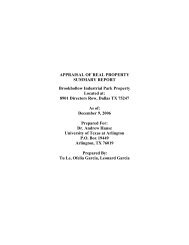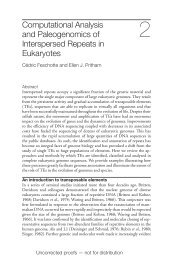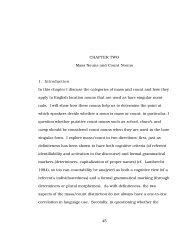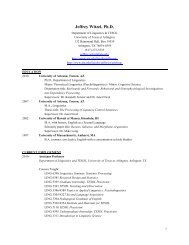Version 001 – Energy Practice – Ross – (20691) 1 This print-out ...
Version 001 – Energy Practice – Ross – (20691) 1 This print-out ...
Version 001 – Energy Practice – Ross – (20691) 1 This print-out ...
You also want an ePaper? Increase the reach of your titles
YUMPU automatically turns print PDFs into web optimized ePapers that Google loves.
<strong>Version</strong> <strong>001</strong> <strong>–</strong> <strong>Energy</strong> <strong>Practice</strong> <strong>–</strong> <strong>Ross</strong> <strong>–</strong> (<strong>20691</strong>) 1<strong>This</strong> <strong>print</strong>-<strong>out</strong> should have 38 questions.Multiple-choice questions may continue onthe next column or page <strong>–</strong> find all choicesbefore answering.APB77FR1mod<strong>001</strong> (part 1 of 3) 0.0 pointsA block of mass 3 kg, which has an initialspeed of 6 m/s at time t = 0, slides on ahorizontal surface.Find the magnitude of the work that mustbe done on the block to bring it to rest.Correct answer: 54 J.Explanation:Let : m = 3 kg andv 0 = 6 m/s.W = ∆K = K f −K 0= 0− 1 2 mv2 0= − 1 2 (3 kg)(6 m/s)2 = −54 J,which has a magnitude of 54 J .002 (part 2 of 3) 0.0 pointsIf a constant friction force of magnitude2 Newtons is exerted on the block by the surface,find the magnitudeof theaccelerationofthe block.Correct answer: 0.666667 m/s 2 .Explanation:F net = maLet : F = 2 N.a = F netm = 2 N3 kg = 0.666667 m/s2 .Correct answer: 27 m.Explanation:W = F ∆x∆x = W F = 54 J2 N = 27 m .CheerleaderLift004 0.0 pointsAcheerleader liftshis43.1kg partnerstraightup off the ground a distance of 0.71 m beforereleasing her.The acceleration of gravity is 9.8 m/s 2 .Ifhedoesthis13times,howmuchworkhashe done?Correct answer: 3898.57 J.Explanation:The work done in lifting the cheerleaderonce isW 1 = mgh= (43.1 kg)(9.8 m/s 2 )(0.71 m)= 299.89 J.The work required to lift her n = 13 times isW = nW 1 = (13)(299.89 J) = 3898.57 J.Comparing Work005 0.0 pointsA block moves to the right in the positive x-direction through the displacement ∆x whileunder the influence of a force with the samemagnitude F. Which of the following is thecorrect order of the amount of work done byforce F, from most positiveto most negative?(a)⃗F003 (part 3 of 3) 0.0 pointsHow far does the block slide before it comesto rest?(b)⃗F
<strong>Version</strong> <strong>001</strong> <strong>–</strong> <strong>Energy</strong> <strong>Practice</strong> <strong>–</strong> <strong>Ross</strong> <strong>–</strong> (<strong>20691</strong>) 2(c)⃗F(d)1. c, a, b, d2. c, a, d, b correct3. a, c, b, d4. a, b, c, d5. a, d, b, c⃗F= 1.116×10 7 J .Conceptual 08 09007 0.0 pointsThe stair stepper is a novel exercise machinethat attempts to reproduce the work doneagainst gravity by walking up stairs. Witheach step, Brad (of mass 50 kg) simulatesstepping up a vertical distance of 0.1 m withthis machine.If Brad exercises for 16 min per day witha stair stepper at a frequency of 60 steps perminute, what total work he does he do eachday? The acceleration of gravity is 9.8 m/s 2 .Correct answer: 47040 J.Explanation:6. d, c, a, b7. d, a, b, cExplanation:W a = 0W b = −F ∆xW c = F ∆xW d = −F cosθ∆xHere, F is the magnitude of the force, ∆xisthemagnitudeof thedisplacement, andθ isthe angle of force in (d) relative to horizontaldirection. So, W c > W a > W d > W b .Conceptual 08 05006 0.0 pointsThe Joule and the kilowatt-hour are bothunits of energy.3.1 kW·h is equivalent to how manyJoules?Correct answer: 1.116×10 7 J.Explanation:1 W = 1 J/s3.1 kW·h = (3.1 kW·h)· 1000 WkW · 3600 s1 h= 1.116×10 7 W·sLet : m = 50 kg,h = 0.1 m,t = 16 min,g = 60 per min, andg = 9.8 m/s 2 .The work done for each stepW = mgh= (50 kg)(9.8 m/s 2 )(0.1 m)= 49 Jand the number of steps in 16 min isn = f t = (60 per min)(16 min) = 960,so the total work isW t = W n = (49 J)(960) = 47040 J .Drag a Crate008 (part 1 of 3) 0.0 pointsSally applies a horizontal force of 382 N witha rope to drag a wooden crate across a floorwith a constant speed. The rope tied to thecrate is pulled at an angle of 59 ◦ relative tothe floor.
<strong>Version</strong> <strong>001</strong> <strong>–</strong> <strong>Energy</strong> <strong>Practice</strong> <strong>–</strong> <strong>Ross</strong> <strong>–</strong> (<strong>20691</strong>) 3FF59 ◦θm382 NF µmF hHow much force is exerted by the ropeon the crate? The acceleration of gravityis 9.8 m/s 2 .Correct answer: 741.693 N.Explanation:Let : F h = 382 N andθ = 59 ◦ .Thehorizontalcomponentoftheforceexertedby the rope is defined bycosθ = F hFF = F hcosθ = 382 Ncos59 ◦ = 741.693 N .009 (part 2 of 3) 0.0 pointsWhat work is done by Sally if the crate ismoved 76.2 m?Correct answer: 29108.4 J.Explanation:The motion is in the direction of the horizontalcomponent, so the work Sally does isW = F h d = (382 N)(76.2 m)= 29108.4 J .010 (part 3 of 3) 0.0 pointsWhat work is done by the floor through forceof friction between the floor and the crate?Correct answer: −29108.4 J.Explanation:Since there is no acceleration, all of herwork is done against friction, so the frictionforce is −W.Holt SF 05Rev 1<strong>001</strong>1 (part 1 of 3) 0.0 pointsA flight attendant pulls her 72.4 N flight baga distance of 289 m along a level airport floorat a constant velocity. The force she exerts is39.3 N at an angle of 52.6 ◦ above the horizontal.a) Findthe work she does on theflight bag.Correct answer: 6898.39 J.Explanation:Basic Concept:Given:Solution:W = F dcosθF g = 72.4 NF applied = 39.3 Nd = 289 mθ = 52.6 ◦W 1 = F k ·d= F applied d cosθ= (39.3 N)(289 m) cos52.6 ◦= 6898.39 J.012 (part 2 of 3) 0.0 pointsb) Find the work done by the force of frictionon the flight bag.
<strong>Version</strong> <strong>001</strong> <strong>–</strong> <strong>Energy</strong> <strong>Practice</strong> <strong>–</strong> <strong>Ross</strong> <strong>–</strong> (<strong>20691</strong>) 4Correct answer: −6898.39 J.Explanation:Basic Concept: Because the bag’s speedis constant,Solution:F net = F k +F applied cosθ = 0W 2 = −W 1= −F k ·d= −F applied dcosθ= −(39.3 N)(289 m)cos52.6 ◦= −6898.39 J.013 (part 3 of 3) 0.0 pointsc) Find the coefficient of kinetic friction betweenthe flight bag and the floor.Correct answer: 0.579654.Explanation:Basic Concept:Solution:µ k = F kF nF k = µ k F n = µ k F g .= −F appliedcosθ−F g +F applied sinθ−(39.3 N)cos52.6 ◦=−(72.4 N)+(39.3 N)sin52.6 ◦−(39.3 N)cos52.6◦=−(41.1795 N)= 0.579654.Holt SF 05Rev 6<strong>001</strong>4 (part 1 of 3) 0.0 pointsA 5.0 kg block is pushed 3.0 m at a constantvelocity up a vertical wall by a constant forceapplied at an angle of 30.0 ◦ with the horizontal,as shown in the figure.The acceleration of gravity is 9.81 m/s 2 .5 kgF3 m30 ◦Drawing not to scale.If the coefficient of kinetic friction betweenthe block and the wall is 0.20, finda) the work done by the force on the block.Correct answer: 225.141 J.Explanation:Basic Concepts:W F = F y dcosθ ′ = Fdsinθsince θ ′ = 0 ◦ ⇒ cosθ ′ = 1.Because v is constant,Given:Solution:F y,net = F sinθ−µ k F n −mg = 0F x,net = F cosθ −F n = 0F n = F cosθm = 5.0 kgθ = 30.0 ◦d = 3.0 mµ k = 0.20g = 9.81 m/s 2F sinθ −µ k F n = mgF sinθ −µ k F cosθ = mgmgF =sinθ −µ k cosθW F = Fdsinθmgdsinθ=sinθ−µ k cosθ= (5 kg)(9.81 m/s2 )sin30 ◦ (3 m)sin30 ◦ −(0.2)cos30 ◦= 225.141 J
<strong>Version</strong> <strong>001</strong> <strong>–</strong> <strong>Energy</strong> <strong>Practice</strong> <strong>–</strong> <strong>Ross</strong> <strong>–</strong> (<strong>20691</strong>) 5015 (part 2 of 3) 0.0 pointsb) the work done by gravity on the block.Correct answer: −147.15 J.Explanation:Basic Concept:W g = F g dcosθ ′ = −mgdsince θ ′ = 180 ◦ ⇒ cosθ ′ = −1.Solution:W g = −(5 kg)(9.81 m/s 2 )(3 m)= −147.15 J016 (part 3 of 3) 0.0 pointsc) the magnitude of the normal force betweenthe block and the wall.Correct answer: 129.985 N.Explanation:Solution:F n = F cosθ(=mgsinθ−µ k cosθ)cosθ= (5 kg)(9.81 m/s2 )cos30 ◦sin30 ◦ −(0.2)cos30 ◦= 129.985 NMoving a Refrigerator 02017 (part 1 of 2) 0.0 pointsTo move a refrigerator of mass 180 kg into ahouse, a mover puts it on a dolly and coversthestepsleadingintothehousewithawoodenplank acting as a ramp. The plank is 3.6 mlong and rises 1.4 m. The mover pulls thedollywithconstantvelocityandwithasteadyforce 2000 N up the ramp.How much work does he perform? Theacceleration of gravity is 9.8 m/s 2 .018 (part 2 of 2) 0.0 pointsWhat is the minimal work required to lift therefrigerator into the house?Correct answer: 2469.6 J.Explanation:As one moves the refrigerator into thehouse, it starts at zero initial velocity andends at zero final velocity. Thus, there is nonetchange oftherefrigerator’skineticenergy,which implies zero net work by all the forcesacting on it,W net = W mover +W gravity +W friction = 0.Since the work of friction forces is never positive,and the work of the gravitational forceW gravity = −mg∆z −2469.6 Jis negative, the mover must provide positiveworkW mover > W minmover = −W gravity = +2469.6 J.keywords:AP B 1998 MC 59 6<strong>001</strong>9 (part 1 of 2) 0.0 pointsA rock of mass m is thrown horizontally offa building from a height h. The speed of therock as it leaves the thrower’s hand at theedge of the building is v 0 as shown.v 0Correct answer: 7200 J.Explanation:The mover pulls the dolly in the directionof its displacement, so his work isW = F∆x = (2000 N)(3.6 m) = 7200 J.h∆x
<strong>Version</strong> <strong>001</strong> <strong>–</strong> <strong>Energy</strong> <strong>Practice</strong> <strong>–</strong> <strong>Ross</strong> <strong>–</strong> (<strong>20691</strong>) 6How much time does it take the rock totravel from the edge of the building to theground?1. t = hv 0g2. t = √ hv 03. t = 2hg√2h4. t =g correct5. t = h v 0Explanation:The motion of the rock in the y-direction isa free falling motion from rest:h = 1 2 gt2√2ht =g .020 (part 2 of 2) 0.0 pointsWhat is the kinetic energy of the rock justbefore it hits the ground?1. K f = mgh2. K f = 1 2 mv2 0 +mgh correct3. K f = 1 2 mv2 04. K f = 1 2 mv2 0 −mgh5. K f = mgh− 1 2 mv2 0Explanation:Bythework-energytheorem,K f −K i = W,where in the present problem, W = (mg)hand K i = 1 2 mv2 0.Thus, K f = K i +W = 1 2 mv2 0 +mgh.Block on an Inclined Plane 01021 (part 1 of 3) 0.0 pointsA block of mass m is pushed a distance D upaninclinedplanebyahorizontalforceF. Theplane is inclined at an angle θ with respect tothehorizontal. Theblockstartsfromrestandthe coefficient of kinetic friction is µ k .FmDIf N is the normal force, what is the workdone by friction?1. W = 0µ k2. W = −µ k N D correct3. W = +µ k (N +mgcosθ)D4. W = −µ k (N −mgcosθ)D5. W = −µ k (N +mgcosθ)D6. W = +µ k (N −mgcosθ)D7. W = +µ k N DExplanation:The force of friction has a magnitudeF friction = µ k N. Since it is in the directionopposite to the motion, we getW friction = −F friction D = −µ k N D.022 (part 2 of 3) 0.0 pointsWhat is the work done by the normal forceN?1. W = (N +mgcosθ +F sinθ)D2. W = (N −mgcosθ −F sinθ)D3. W = 0 correct4. W = (mgcosθ +F sinθ −N)D5. W = N Dsinθθ
<strong>Version</strong> <strong>001</strong> <strong>–</strong> <strong>Energy</strong> <strong>Practice</strong> <strong>–</strong> <strong>Ross</strong> <strong>–</strong> (<strong>20691</strong>) 76. W = N Dcosθ7. W = −N D8. W = N DExplanation:The normal force makes an angle of 90 ◦with the displacement, so the work done by itis zero.023 (part 3 of 3) 0.0 pointsWhat is the final speed of the block?1. v =√2m (F cosθ −mgsinθ −µ kN)DcorrectThusv f =√2m (F cosθ −mgsinθ −µ kN)D.Cannon 01024 (part 1 of 6) 0.0 pointsA projectile of mass 0.314 kg is shot froma cannon, at height 6.7 m, as shown in thefigure, with an initial velocity v i having ahorizontal component of 6.4 m/s.Theprojectilerisestoamaximumheightof∆y above the end of the cannon’s barrel andstrikes the ground a horizontal distance ∆xpast the end of the cannon’s barrel.v i∆y2. v =√2m(F cosθ +mgsinθ)D3. v =√2m (F sinθ −µ kN)D51 ◦6.7 m4. v =√2m (F cosθ −mgsinθ +µ kN)D5. v =√2m (F cosθ +mgsinθ −µ kN)D6. v =√2m(F cosθ −mgsinθ)D7. v =√2m (F cosθ −µ kN)D8. v =√2m (F sinθ +µ kN)DExplanation:The work done by gravity isW grav = mgDcos(90 ◦ +θ)= −mgDsinθ.The work done by the force F isW F = F Dcosθ.From the work-energy theorem we know thatW net = ∆K,W F +W grav +W friction = 1 2 mv2 f .∆xDetermine the vertical component of theinitialvelocity at the end of the cannon’s barrel,where the projectile begins its trajectory.The acceleration of gravity is 9.8 m/s 2 .Correct answer: 7.90334 m/s.Explanation:Let : v xi = 6.4 m/s andθ = 51 ◦ .tanθ = v yiv xiv yi = v xi tanθ = (6.4 m/s)tan51 ◦= 7.90334 m/s .025 (part 2 of 6) 0.0 pointsDetermine the maximum height ∆y the projectileachieves after leaving the end of thecannon’s barrel.
<strong>Version</strong> <strong>001</strong> <strong>–</strong> <strong>Energy</strong> <strong>Practice</strong> <strong>–</strong> <strong>Ross</strong> <strong>–</strong> (<strong>20691</strong>) 8Correct answer: 3.18688 m.Explanation:so from the work-energy theorem,W = ∆K = 1 2 mv2 f − 1 2 mv2 iLet : v ytop = 0.vyi 2 = vy 2 top+2g∆y = 2g∆y√ √vyi2 ∆y =2g = (7.90334 m/s) 22(9.8 m/s 2 )= 3.18688 m .026 (part 3 of 6) 0.0 pointsFind the work done by the gravitational forceon the projectile during the motion in itstrajectory.Correct answer: 20.6172 J.Explanation:Let : (x i ,y i ) = (0 m,6.7 m).The work done by gravity depends onlyon the vertical distance y i , since the workinvolving∆y addsandsubtracts; i.e.,cancels,soW = mgy i= (0.314 kg)(9.8 m/s 2 )(6.7 m)= 20.6172 J .027 (part 4 of 6) 0.0 pointsFind the magnitude of the velocity vectorwhen the projectile hits the ground.Correct answer: 15.3213 m/s.Explanation:Let : m = 0.314 kg.v xi = v i cosθv i = v x i6.4 m/s=cosθ cos51 ◦= 10.1697 m/s,12 mv2 f = W + 1 2 mv2 i√2Wv f =m +v2 i√2(20.6172 J)= +(10.1697 m/s)0.314 kg2= 15.3213 m/s .Alternate Solution: The magnitude ofthe final vertical velocity is|v yf | = √ 2g[y i +∆y]√= 2(9.8 m/s 2 )(6.7 m+3.18688 m)= 13.9206 m/s, so√v f = vy 2 f+vx 2 i√= (13.9206 m/s) 2 +(6.4 m/s) 2= 15.3213 m/s .028 (part 5 of 6) 0.0 pointsFind the magnitude of the angle (with repectto horizontal) the projectile makes when impactingthe ground.Correct answer: 65.3094 ◦ .Explanation:( )∣ |θ f | =∣ arctan vyf ∣∣∣v (xi)∣ =13.9206 m/s ∣∣∣∣ arctan 6.4 m/s= 65.3094 ◦ .
<strong>Version</strong> <strong>001</strong> <strong>–</strong> <strong>Energy</strong> <strong>Practice</strong> <strong>–</strong> <strong>Ross</strong> <strong>–</strong> (<strong>20691</strong>) 9029 (part 6 of 6) 0.0 pointsFind the range ∆x of the projectile.Correct answer: 14.2524 m.Explanation:y = 0, soSincey = y i +v yi t− 1 2 gt2( g2v 2 x i)a = g2v 2 x i== y i + v y iv xix− g 2x 2 −(vyiv xi)x 2v 2 x i= 0x+y i = 09.8 m/s22(6.4 m/s) 2 = 0.119629 m−1 ,b = − v y i7.90334 m/s= −v xi 6.4 m/sc = −y i = −6.7 m, andb 2 −4ac = (−1.2349) 2= −1.2349,−4(0.119629 m −1 )(−6.7 m)= 4.73103,x = −b±√ b 2 −4ac2a= 1.2349±√ 4.731032(0.119629 m −1 )= 14.2524 m .Inclined plane consv energy030 0.0 pointsA block is released from rest, at a height h,and allowed to slide down an inclined plane.There is friction on the plane. At the bottomof the plane, there is a spring that the blockwill compress. After compressing the spring,theblockwillslideuptheplanetosomemaximumheight,h A ,afterwhichitwillagainslideback down.How much work is done on the block betweenits release at height h and its ascent toits next maximum height?1. 0 correct2. 2µm A gh A3. m A g(h−h A )+2µm A gh A4. More information is needed.5. None of these6. m A g(h − h A )Explanation:The important thing to remember here isthe work energy theorem, ∆K = ∆W. Sincethe block starts from rest and again is at restat its maximum height, then we know thekineticenergy is thesame, 0. Since the ∆K is0, then so must the ∆W. Therefore, no workis done.Pulled Block 02031 (part 1 of 2) 0.0 pointsGiven: A block is pulled at a constant speedalong a horizontal surface by a rope with tensionFT . The ropeisinclinedat ananglefromthe horizontal as shown in the figure below.The block moves a distance 15 m along thehorizontal surface.The acceleration of gravity is 9.8 m/s 2 .25 kgF T28 ◦µ = 0.7What is the net work done by all the forcesacting on the block?1. W net < 02. W net > 03. W net = 0 correctExplanation:
<strong>Version</strong> <strong>001</strong> <strong>–</strong> <strong>Energy</strong> <strong>Practice</strong> <strong>–</strong> <strong>Ross</strong> <strong>–</strong> (<strong>20691</strong>) 10Because the block is moving at a constantspeed, the net force on it is zero. So the network is also zero.032 (part 2 of 2) 0.0 pointsSuppose that the force on the block F T is increasedso that theblock accelerates (startingfrom rest) at a = 2.2 m/s 2 .Now what is the net work done by all theforces acting on the block as it moves a distanceof 15 m?Correct answer: 825 J.Explanation:Let L = 15 m.W = ∆K = 1 2 m∆v2= 1 2 m(2aL)= maL= (25 kg)(2.2 m/s 2 )(15 m)= 825 J.Sliding a Box033 (part 1 of 4) 0.0 pointsA32.3kgboxinitiallyatrestispushed2.87malongarough,horizontalfloorwithaconstantapplied horizontal force of 129.087 N.If the coefficient of friction between boxand floor is 0.362, find the work done by theapplied force. The acceleration of gravity is9.8 m/s 2 .Correct answer: 370.481 J.Explanation:The work done by the applied force is givenbyW F = F s = (129.087N)(2.87m) = 370.481J034 (part 2 of 4) 0.0 pointsFind the work done by the friction.Correct answer: −328.866 J.Explanation:The work done by the friction is given byW f = f s = −µ m g sW f = −0.362(32.3kg)(9.8m/s 2 )(2.87m) = −328.86035 (part 3 of 4) 0.0 pointsFind the change in kinetic energy of the box.Correct answer: 41.615 J.Explanation:The net work done is given byW net = W F +W f = 370.481J+(−328.866J) = 41.61036 (part 4 of 4) 0.0 pointsFind the the final speed of the box.Correct answer: 1.60524 m/s.Explanation:The change in kineticenergy isequal tothenet work done, so∆K = W net = m v2 f2The initial velocity is zero, sokeywords:− m v2 i2√2 Wnetv f =m√2 (41.615 J)=32.3 kg= 1.60524 m/sTipler PSE5 06 60037 (part 1 of 2) 0.0 pointsA simple Atwood’s machine uses two massesm 1 and m 2 . Starting from rest, the speed ofthe two masses is 5.6 m/s at the end of 1.6 s.At that time, the kineticenergy of the systemis 26 J and each mass has moved a distance of4.48 m.The acceleration of gravity is 9.81 m/s 2 .
<strong>Version</strong> <strong>001</strong> <strong>–</strong> <strong>Energy</strong> <strong>Practice</strong> <strong>–</strong> <strong>Ross</strong> <strong>–</strong> (<strong>20691</strong>) 11m 1 +m 2 = 1.65816 kgm 1 −m 2 = 0.591597 kg1.65816 kg+0.591597 kgm 1 =2= 1.12488 kg .m 14.48 mm 2Find the value of heavier mass.Correct answer: 1.12488 kg.Explanation:038 (part 2 of 2) 0.0 pointsFind the value of lighter mass.Correct answer: 0.533283 kg.Explanation:m 2 =1.65816 kg−0.591597 kg2= 0.533283 kg .Let : v = 5.6 m/s,t = 1.6 s,K = 26 J,l = 4.48 m, andg = 9.81 m/s 2 .The total kinetic energy of the system isK = 1 2 (m 1 +m 2 )v 2m 1 +m 2 = 2K 2(26 J)= = 1.65816 kgv2 (5.6 m/s) 2( )m1 −m 2a = gm 1 +m 2∑F = (m1 +m 2 )a(m 1 −m 2 )g = (m 1 +m 2 )a( )m1 −m 2a = gm 1 +m 2The velocity isv = at = (m 1 −m 2 )gtm 1 +m 2m 1 −m 2 = (m 1 +m 2 )vgt(1.65816 kg)(5.6 m/s)=(9.81 m/s 2 )(1.6 s)= 0.591597 kg.


